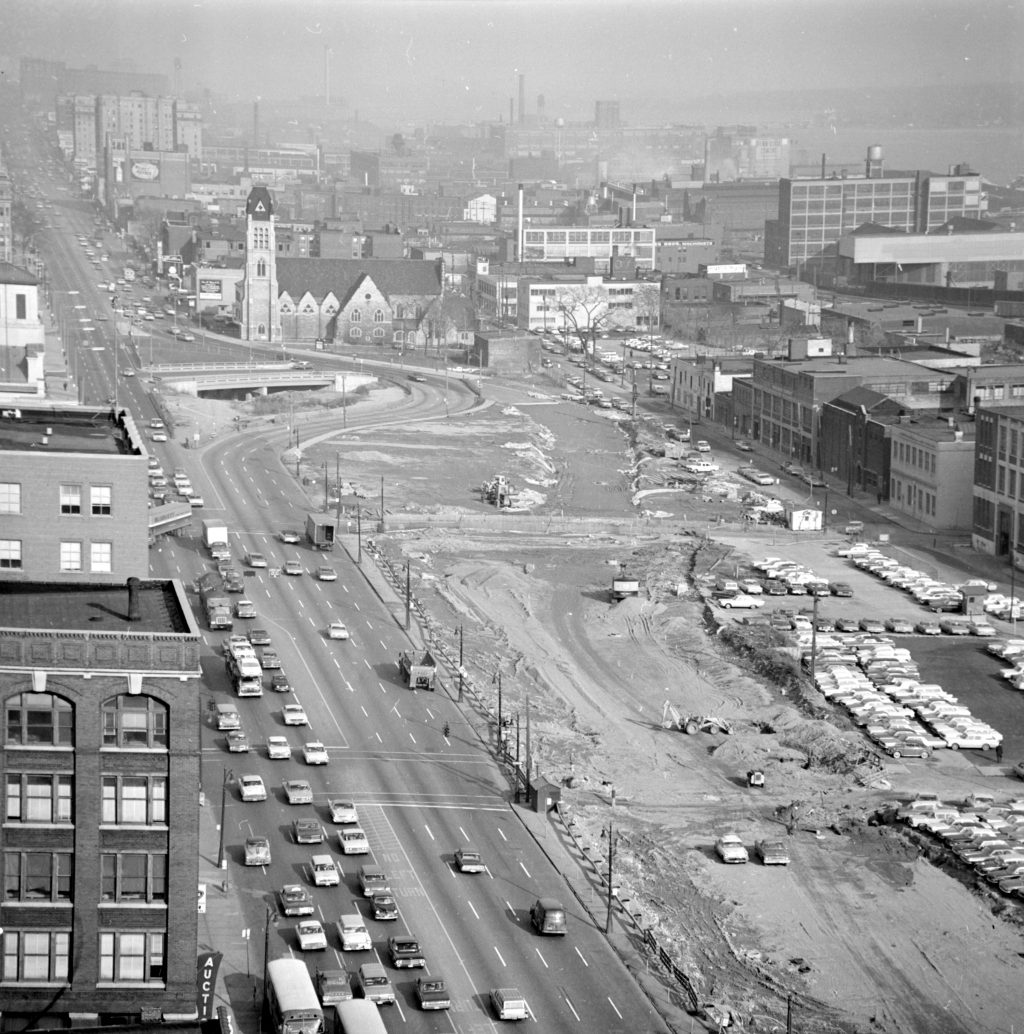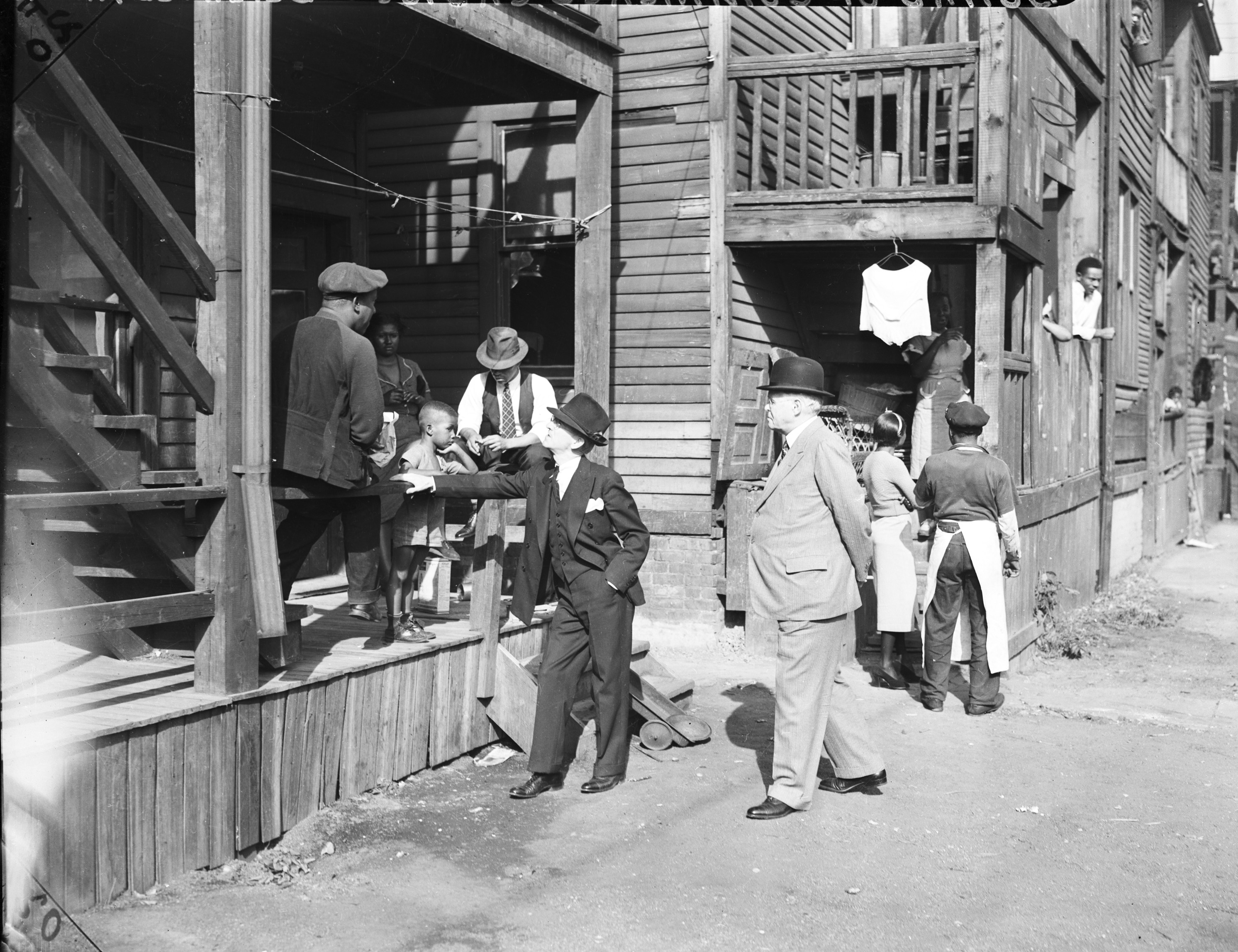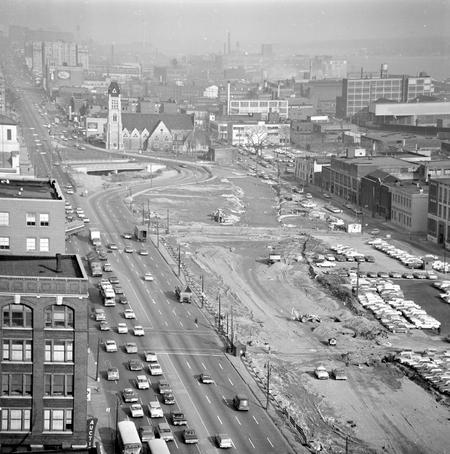CuriosiD: How A 1900s Black Detroit Community Was Razed For A Freeway
An entire Detroit neighborhood vanished to make way for the future. Here’s Black Bottom’s story.

This week’s installment of CuriosiD investigates a question from listener Peter Pasque of Ann Arbor.
“A good friend of mine told me years ago the Black Bottom neighborhood was the hub of African American community and a business district was thriving, and a decision was made to build 75 through the community and it decimated its vibrancy. Is this true?” – Peter Pasque
The Short Answer
Peter, your friend is correct. Black Bottom was a predominately African American neighborhood with an estimated 350 black-owned businesses. The neighborhood was razed, along with neighboring “Paradise Valley”, to make way for the I-75 construction.
Behind the Name
“Black Bottom” is often thought – even by some residents of the day – to have been a racial epithet aimed at the east side neighborhood near downtown. But that’s not the case.
“Not at all,” says Ken Coleman, a Detroit-based historian and author. “The term Black Bottom goes all the way back to French settlers who were here in this part of the region. They were farmers and that land was very much known for being fertile for farming purposes. It had a black texture and color to it and there were marches in the area and they named the area Black Bottom. That’s really where it came from.”
By the late 1800s French farmers and fur traders had long moved on and other European immigrants came to Detroit –Italians, Germans, Polish, Russian Jews. The major influx of African Americans in Detroit began in earnest with the Great Migration of the early 20th century.

How Black Bottom Became Predominately Black
“Detroit is a melting pot, and African Americans come primarily from the south,” says a woman in a 1975 interview about her neighborhood. “Everybody was from the South at that time. See if you were born in Detroit that was a distinction.”
She says men and women were coming north for jobs in manufacturing.
“Everybody was coming up because Ford was offering his $5-a-day, and they were packing families into one room and charging them about $50 in rent, which was exorbitant at that time because they were only making $5 a day.”
They were packing families into Black Bottom homes because there were limited options. Black families were rarely allowed to purchase homes.
“…Restricted covenants and deeds restricted you from living in most of the city, and really, outside of a couple of small enclaves in Detroit, Black Bottom was the only place you could live,” says Ken Coleman.
Perhaps as much as 80% of deeds in Detroit prevented Black homeownership. So African American families were forced to live in Black neighborhoods. By some estimates there were 350 black-owned businesses in Black Bottom – doctors, lawyers, restaurants, pharmacies, general stores, and entertainment venues.
Support the news you love.
Here at WDET, we strive to make our journalism accessible to everyone. As a non-profit public media institution, we maintain our journalistic integrity through independent support from readers like you. Because you value WDET as your source of news, music, and conversation, please make a gift of support today. Even $5 a month helps!
A Street of Art and Vice
Paradise Valley was the adjoining neighborhood to the north, where bars and clubs filled the main thoroughfare – Hastings Street. Music and dance spilled into the streets. Jazz, Blues, and the early notes of Rock and Soul. And despite living arrangements, Black and white folks intermingled in the bars.
“There were many music venues called Black and Tans,” says Coleman. “Where African Americans and whites could enter as patrons – could be workers, could be owners – it wasn’t uncommon, for example, to see affluent whites from Grosse Pointe take on the entertainment scene along Hastings St. in Paradise Valley, whether they would be jazz clubs or blind pigs or the blues scene. There was a very vibrant blues scene emanating from Paradise Valley.”
And there was a vibrant vice scene as well. Alcohol, gambling, organized crime running the numbers, and of course the world’s oldest profession- prostitution.
Prostitution was considered by some to be a respectable profession in the Black Bottom, Paradise Valley area. Black women were largely barred from employment in the workplace, and white immigrants were hired first for childcare and housework.
Black Bottom and Paradise Valley became known nationally as an incubator of musical talent and a good time. But overcrowding from immigration and the Great Migration took its toll on the infrastructure in Black Bottom. Ken Coleman says city officials began to take notice.
Making Way for the Future

“A term becomes very popular in the 1930s, ‘40s and ‘50s, called ‘Slum Clearance.’ And that is a government political term speaking to sections of town that have inadequate structures. Fire hazards. They don’t have plumbing, their rooves are sinking in, the porches the steps are falling apart. And that’s largely what Black Bottom was in terms of the structures that were there.”
John Gallagher, a Detroit Free Press reporter, says the buildings were so outdated, that if one were to dig beneath the surface, one would find wooden sewer pipes.
“So they really thought there were wiping out slums and creating modern middle class housing,” he says.
Gallagher says officials made plans to clear Black Bottom and Paradise Valley in favor of what they believed to be a cleaner, shinier future.
“I think you have to go back perhaps to the World’s Fair in 1939 in New York with the Futurama and the GM inspired vision of what a city was, and how where expressways were obviously the way to go. And everybody bought into that, and Detroit as much or more as anybody.”
Freeways, highways and byways designed for high rates of speed in and out of city centers. Wide monoliths driven through the perceived valueless land of slums.
“We understand now that a lot of the neighborhoods that were wiped out – Corktown, much of Greektown, all of Black Bottom – those were the walkable urban neighborhoods we now prize and now we’re trying to reinvent those neighborhoods,” says Gallagher.
I-75 and I-375 were plotted out directly along Black Bottom and Paradise Valley’s main artery – Hastings St.
A brand new affordable housing concept came along – the now-infamous Brewster housing project, which provided a clean brick façade on the promise of a better tomorrow. But the city did little to help relocate residents as “slum clearance” took hold, particularly for African Americans who most often rented from white landlords.
Gallagher says freeways didn’t live up to their potential.
“That was a misguided notion that somehow freeways were going to benefit cities, and instead what they’ve done is destroyed neighborhoods.”
By the 1950s and ‘60s the hope of Urban Renewal also brought steel, and glass, and modern architectural triumphs such as Lafayette Park to Black Bottom, Detroit and the rest of the country.
Lasting Ramifications
“There aren’t many people that would argue against taking a community and rebuilding it,” says Coleman. “The problem is for places like Black Bottom, Urban Renewal meant Negro Removal.”
Coleman says that legacy had major implications that are still felt in our metro region, even though Black Bottom has been gone for several generations.
“At least in terms of issues of race in our major metropolitan area, I think it was ground zero.”
There was a recent effort to remove and reimagine the mile-long stretch of I-375 in the heart of the area once known as Black Bottom, but that’s been put on hold by officials for the time being.
WDET’s Shelby Jouppi designed the online version of this story.
